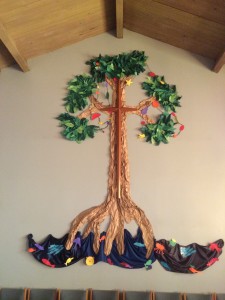You are not alone…no one is alone.”
– Into the Woods, Stephen Sondheim & James Lapine
Beloved of God,
None in our family had ever seen the musical Into the Woods,* so when I learned last spring that 12th Night Productions had chosen it for their summer theatre offering I was intrigued. My interest steadily grew as I sat through a number of church meetings at Peace while rehearsals took place downstairs. The voices from below were engaging; the energy of the players high. When we returned from vacation a single performance remained—the Sunday matinee—and Chris acquired the tickets. Now I’ve tried Sunday theater matinees before and they usually don’t work for me. On Sunday afternoons a nap is a more appealing activity than a performance. But we’d really been looking forward to this show, and so Sunday afternoon the four of us piled into the car and went.
What we experienced there in the West Seattle High Theater was absolutely transporting. From the first line of the opening song we were hooked. Hooked not only by the incredible voices from the large and uniformly talented cast, but by the level of artistry they achieved together, and most of all by the message at the heart of the show. There would be no napping through this production!
On the surface, the show is a clever and entertaining interweaving of well-known fairy tales—Cinderella, Little Red Riding Hood, Jack and the Beanstalk, Rapunzel, and others. With music and verse, Sondheim and Lapine masterfully link the stories and their characters to the fundamental human experience of running up against limits, making choices whose consequences linger, and confronting loss while longing for redemption and fulfillment—the “happily ever after” that beckons to us from the other side of the woods. But we have to go “into the woods” in order to get there, and therein lies the tale. Act 1 ends with a note of joyous relief that wishes have been granted, goals have been attained and predicaments solved. Then comes Act 2, and complications ensue. What seemed black and white turns gray.
In her Director’s Note for the show, Mary Opland Springer writes:
In Act 2 we take this journey with [the characters] and realize that a journey into the woods brings as many questions as it answers. In one of the most poignant moments, Cinderella and the Baker share the wisdom they have realized as they sing No One Is Alone
Sometimes people leave you halfway through the wood.
Others may deceive you. You decide what’s good.
You decide alone. But no one is alone.
Mary goes on:
Sondheim so aptly said, “No One is Alone…is what the show has been about. No one is alone: we are all connected in some way and we are all responsible for each other’s actions.”
The Rev. Martin Luther King, Jr. once said something similar in a letter he wrote from a Birmingham jail cell: “We are caught in an inescapable network of mutuality, tied in a single garment of destiny. Whatever affects one directly, affects all indirectly.”[1]
Our family of four—kids as well as adults—were entranced by the artistry of the cast and musicians in their portrayal of this masterful show. Kai and Naomi quickly pronounced it “the best play ever,” and Chris and I found ourselves profoundly moved as we recognized in the drama on stage some of our own experiences of being stuck “in the woods.” The show reminded us that this is what the journey we’re on together—all of us—is about: we are not alone. We experienced this as gospel. We have one another. And more than that, we are companioned by One who enters “the woods” by our side; who will do whatever it takes to get us through to the other side.
As the season turns and the launch of a new school year begins, we need this reminder. And the good news is, we get to hear, touch, and taste it each Sunday we come together. We need each other. We are not alone.
See you at the Table,
Pastor Erik
___________________________
* Music by Stephen Sondheim, libretto by James Lapine
[1] Find the full text of King’s letter here: http://www.africa.upenn.edu/Articles_Gen/Letter_Birmingham.html





